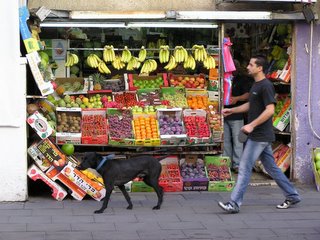

It is Thursday. Kara and I are on an excursion to Tel Aviv to explore the Bauhaus architecture there. Kara is studying art and photography and her interest in things visual is growing. Tel Aviv is the only city in the world built mostly in the Bauhaus style. We choose to stroll along Rothschild Street, also meandering down some of the adjacent side streets.
I learned that in July, 2003, UNESCO, (United Nations Educational, Scientific and Cultural Organization) proclaimed Tel Aviv "The White City" as a World Cultural Heritage site. In order to receive this award, a city must have some aspect that is of international interest and not merely interesting to local inhabitants. I think I read somewhere that Tel Aviv is one of only 2 modern cities in the world to receive such a designation, the other being Brasilia.
It is ironic to note (and I know I shouldn't chuckle, but I do) that this style of architecture developed in pre-Nazi Germany and
when the Nazis came into power, the style came to an abrupt halt. Many of the architects who were Bauhaus trained emigrated to Israel. Now it is the city of Tel Aviv that is world renown for this German-born style of architecture. (sorry Shulzie)
People refer to the 'White City,' when they discuss Tel Aviv Bauhaus. I am expecting to see everything pure and clean and beautiful, like the Emerald City in the Wizard of Oz. We are, however, noting with a bit of disappointment, that the buildings we encounter are in a state of sad disrepair. In retrospect, I suppose it is a bit silly to expect anything to remain pristine given the substantial shift in financial priorities that was the outfall of the Yassar Arafat regime.
We are both anxious to see what will become of these buildings over the next decade. I understand that the World Cultural Heritage Site designation will require that Tel Aviv invests some money in repair and maintenance. Hopefully, we will have another visit where the 'White City' is once again sparkling. Next year in Tel Aviv!!
Regarding what to expect and know when looking at Bauhaus designs, we find the following information helpful:
There are a number of characteristics to the Bauhaus/International Style of architecture:
1) It shuns ornamentation and favors functionality
2) Uses asymmetry and regularity versus symmetry
3) It grasps architecture in terms of space versus mass Bauhaus buildings are usually cubic, favor right angles, (although some feature rounded corners and balconies); they have smooth facades and an open floor plan.
Bauhaus architecture was concerned with the social aspects of design and with the creation of a new form of social housing for workers. This may be just another one of the reasons it was embraced in the newly evolving city of Tel-Aviv, at a time when socialist ideas were so prevalent. This style of architecture came about (in part) because of new engineering developments that allowed the walls to be built around steel or iron frames. This meant that walls no longer had to support the structure, but only enveloped it – from the outside.
Tel Aviv has the largest number of cooperative workers’ apartments in the country. The aim was to provide residents with as much equality in living quarters. These blocks of apartments, operated almost as self-contained units. Residents had a variety of services right in the buildings, including kindergarten, post office, convenience store, laundry etc. Additionally, a plot of land was set aside, so that residents could grow their own vegetables. Having a ‘connection to the land’ was viewed as extremely important.
[ Source:
www.gemsinisrael.com]
If you're interested in more, then you need to get a life. Really!! On second thought, make another cup of coffee or tea and forget reality. Just sit back and surf and enjoy these these two very informative links:
http://www.gemsinisrael.com/e_article000020538.htmhttp://www.white-city.co.il/english/index.htmSo, if you have now been swept off your feet and have just bought a ticket to Israel, having sold off all of your possessions so you can live in one of these incredible bulidings, you might want to stuff into your suitcase the printed version of this free downloadable walking guide: (or if your just planning to visit...)
1. Go to English in the White-City site, select from the left: Tourism.
2. From there one will see three street names: Dizengoff, Rothchild and Bialik. Click on one.
3. Click where it says:
ROUTE GUIDE PRINT VERSION4. Do this for one or all of the streets. There are photos of each of the noted buildings along with a snippet of historical explanation.
[Thanks to cousin Marcia for directing me to this walking guide!!]

 For the past few years I have been making my own holiday cards. They are a wonderful way for our family to reach out to people with whom we have connected, but perhaps now have more desire than time to maintain that connection. Often, we find friends that have moved. In response, sometimes we receive warm e-mails or phone calls or personal notes that help keep the relationship alive as well. Life is busy and it is a struggle. But staying in touch is very rewarding.
For the past few years I have been making my own holiday cards. They are a wonderful way for our family to reach out to people with whom we have connected, but perhaps now have more desire than time to maintain that connection. Often, we find friends that have moved. In response, sometimes we receive warm e-mails or phone calls or personal notes that help keep the relationship alive as well. Life is busy and it is a struggle. But staying in touch is very rewarding.















